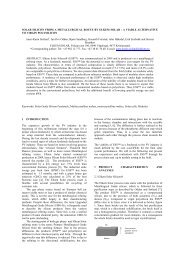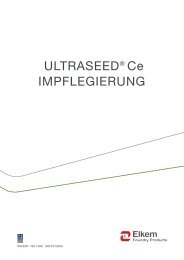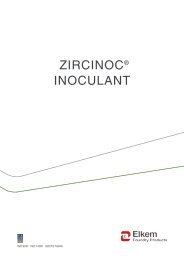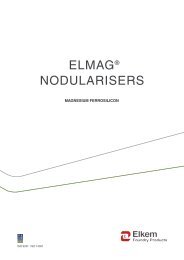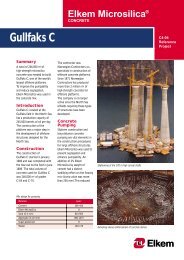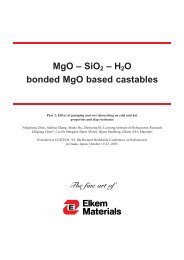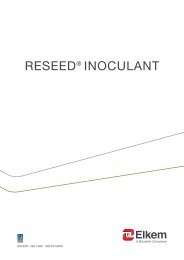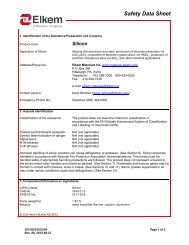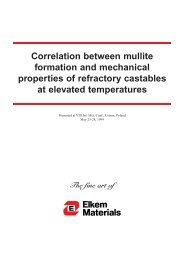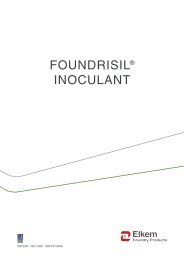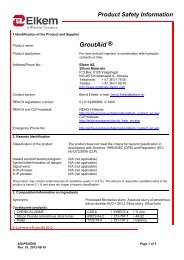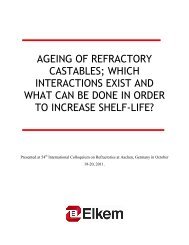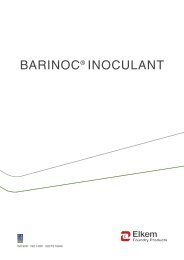New additive packages for self-flowing high-alumina and ... - Elkem
New additive packages for self-flowing high-alumina and ... - Elkem
New additive packages for self-flowing high-alumina and ... - Elkem
You also want an ePaper? Increase the reach of your titles
YUMPU automatically turns print PDFs into web optimized ePapers that Google loves.
NEW ADDITIVE PACKAGESFOR SELF-FLOWINGHIGH-ALUMINA ANDMgO BASED REFRACTORYCASTABLESPresented at ALAFAR congress, Cancun, Mexico in November 05-08,2012.
NEW ADDITIVE PACKAGES FOR SELF-FLOWING HIGH-ALUMINA ANDMgO BASED REFRACTORY CASTABLESHong Peng* 1 , Ming Luo 2 <strong>and</strong> Bjørn Myhre 31,3<strong>Elkem</strong> Silicon Materials, Kristians<strong>and</strong>, Norway2Wuhan University of Science <strong>and</strong> Technology, Wuhan, China*Email: hong.peng@elkem.noABSTRACTSelf-<strong>flowing</strong> refractory castables with special per<strong>for</strong>mance are continuously beingdeveloped. <strong>New</strong> <strong>and</strong> improved dispersant systems play an essential role in thisdevelopment. The objective of this paper is to <strong>high</strong>light the benefits of two noveladmixture systems that have been tested in various refractory castables.SioxX/SioxX-Quick is a specialty <strong>additive</strong> package developed <strong>for</strong> use in microsilicacontaining <strong>alumina</strong> based castable systems. The main function of SioxX is to controlflow properties whereas SioxX-Quick controls setting characteristics. In combinationthey will enable the castable producer to control flow <strong>and</strong> set time accurately. WhenSioxX replaces sodium hexametaphosphate, <strong>self</strong>-flow is improved by 20 to 30% <strong>and</strong>shelf-life of dry premixes is significantly improved.SioxX-Mag is a new <strong>additive</strong> package being developed <strong>for</strong> basic refractory castables.It contributes to better workability <strong>and</strong> setting behavior of MgO based castables whilehot-properties remain unchanged. High per<strong>for</strong>mance, cement-free MgO castablesbased on MgO-SiO 2 -H 2 O bond using SioxX-Mag as dispersant have been tested.Using SioxX-Mag together with microsilica, slaking caused by brucite <strong>for</strong>mation issuppressed <strong>and</strong> crack-free dried samples are made. Another benefit of using this<strong>additive</strong> package is the improved drying characteristics allowing fast firing of thecastable.1. INTRODUCTIONCharacteristics of advanced <strong>self</strong>-<strong>flowing</strong> refractory castables are ease of installation,possibility to cast intricate shapes, energy savings <strong>and</strong> better per<strong>for</strong>mance ingeneral. Important factors to control in these castables include particle sizedistribution (PSD), <strong>additive</strong>s (deflocculants, dispersants, accelerators) 1,2 <strong>and</strong> the rawmaterials, particularly with respect to the super-fines <strong>and</strong> cement 3,4 . Numerousrecent research programs have focused on underst<strong>and</strong>ing the mechanism ofdispersion <strong>and</strong> optimization of dispersants <strong>for</strong> specific castables 5,6,7,8 No doubt,dispersants continue to play an essential role in further development of advancedrefractories.
For state-of-the-art steel-making <strong>and</strong> clean steel production <strong>high</strong>-per<strong>for</strong>mance basicrefractory castables are of particular importance. Already in 1989, <strong>Elkem</strong> Materialsstarted development work on a new binder system <strong>for</strong> basic castables based on thereaction between MgO fines, microsilica (SiO 2 ) <strong>and</strong> water 9 . This bond system wasfirst applied to magnesia, silicon nitride <strong>and</strong> magnesia-carbon castables <strong>and</strong> requiredlow water addition (5.0-5.5%) resulting in adequate mechanical properties. Animportant observation was that at 6% microsilica addition no slaking occurred. Sincethen, significant research on the use of microsilica in basic castables has beenrun 10,11,12,13 . It has been demonstrated that with appropriate <strong>additive</strong>s <strong>and</strong> choice ofraw materials, <strong>self</strong>-<strong>flowing</strong> cement-free MgO-SiO 2 bonded castables can beproduced. About 6 wt% microsilica seems to be essential to obtain both goodplacement <strong>and</strong> hot properties. A surprising observation is that the slag resistance toboth BOF <strong>and</strong> EAF slag compared to an <strong>alumina</strong> spinel castable is improved 11 .Recently, many research programs have focused on hydration mechanism ofmagnesia with water <strong>and</strong> <strong>additive</strong>s (dispersants <strong>and</strong> retarders) in systems such asMgO-SiO 2 -H 2 O, MgO-Al 2 O 3 -H 2 O <strong>and</strong> MgO-SiO 2 -Al 2 O 3 -H 2 O 14,15,16,17 . However, <strong>self</strong><strong>flowing</strong>magnesia castables have not been widely used until now. One of thechallenges is that during the hydration process brucite is <strong>for</strong>med which causesvolume expansion <strong>and</strong> subsequent cracking- aphenomenon commonly called“slaking” 18 . Although it has been demonstrated that the interaction between MgO <strong>and</strong>SiO 2 prevents slaking, the mechanism has not been fully understood.For more than 30 years, <strong>Elkem</strong>’s focus has been on underst<strong>and</strong>ing the influence ofmicrosilica on the properties of refractory castables. Microsilica (SiO 2 ) consists ofspherical particles of amorphous silicon dioxide (SiO 2 ) with an average particle sizeof 0.15 micron (150 nanometres). The most important benefits of microsilica incastables are:i) Increased packing densityii) Improved flowability, i.e. reduction in mixing water needed <strong>for</strong> a givenflow 19iii) Contribution to <strong>high</strong>-temperature strength due to <strong>for</strong>mation of mullite attemperature above 1300 o C in <strong>alumina</strong> based castables 20iv) Bond <strong>for</strong>mation by interaction with MgO fines <strong>and</strong> avoidance of “slaking”during set <strong>and</strong> drying of MgO-based castables 14-17 .Based on our experience from the use of microsilica in different refractory castables,two types of <strong>additive</strong> <strong>packages</strong> have recently been developed. SioxX/SioxX-Quick is<strong>for</strong> <strong>high</strong>-<strong>alumina</strong> castables <strong>and</strong> SioxX-Mag <strong>for</strong> basic castables. For ease ofapplication <strong>and</strong> improved functionality, <strong>high</strong>-grade microsilica is used as carrier inthese products. As seen in the following this is compensated <strong>for</strong> in the mix design byreducing the microsilica dosage correspondingly.2. EXPERIMENTAL2.1 Composition design – SioxX/SioxX-QuickSioxX/SioxX-Quick has been tested in a variety of refractory castables such as whitefused, mulcoa <strong>and</strong> bauxite based systems 21 . Here, a SiC based LCC is selected toinvestigate the key parameters affecting shelf-life of LCC premixes <strong>and</strong> the impact of
dispersants on the properties of <strong>self</strong>-<strong>flowing</strong> LCC. As seen in Table 1, 6% cementwas used. The Ref-I mix with sodium hexametaphosphate (SHMP) as dispersant is atype of mix used industrially <strong>and</strong> is the reference <strong>for</strong> comparison with SioxX/SioxX-Quick mixes.Table 1: Composition of SiC based LCC (wt%)Ref-I SX-I SX/SX-Q-I<strong>Elkem</strong> Microsilica 971U 10 8.7 8Cement 6 6 6SiC 72 72 72Calcined <strong>alumina</strong> 13 12.3 12SHMP 0.2SioxX 2 2SioxX-Quick 1Water 5.50 5.50 5.50To investigate the effect of humidity on shelf-life, dry-mixed 25 kgs samples packedin closed, plastic lined paper bags were stored in a temperature <strong>and</strong> humiditycontrolled room (“climate room” with 70-80 % relative humidity at 20 °C). Thesestorage conditions have been used several times be<strong>for</strong>e <strong>and</strong> give an acceleratedageing of the castable.2.2 Composition design – SioxX-MagConcerning SioxX-Mag (prototype), cement free MgO-based castable is used tocompare the effects of various dispersants on flow, MgO hydration mechanism <strong>and</strong>hot properties. Table 2 shows the composition of the castables with an optimizedparticle size distribution. Commercially available dispersants A <strong>and</strong> B <strong>and</strong> the newSioxX-Mag (prototype) from <strong>Elkem</strong> are used. The dosage level of the dispersants areoptimized, 0.25% <strong>for</strong> A <strong>and</strong> B, <strong>and</strong> 2% <strong>for</strong> SioxX-Mag. The water addition is kept at5.5% <strong>for</strong> all mixes.Table 2: Composition of gel-bonded MgO based castable (wt%)M1 M2 M3NedMag MgO 5-3 mm 12 12 123-1 mm 24 24 241-0 mm 27 27 27100 mesh 10 10 10325 mesh 21 21 20.5<strong>Elkem</strong> Microsilica 971U 6 6 4.5Dispersants A 0.25B 0.25SioxX-Mag (prototype) 2Water 5.5
2.3 MeasurementsSelf-flow of the freshly mixed castable (after four minutes wet-mixing) was measuredusing the flow-cone described in ASTM C230 (height of 50 mm, not the more recentcone of 80 mm described in EN 1402-4:2003). The <strong>self</strong> flow value is the % increaseof the diameter of the fresh mix measured 90 seconds after removing the cone.Set time is normally defined as the time from mixing to the first noticed temperatureincrease in the mix. This is often referred to as the working time. Fresh samples wereplaced in insulated boxes <strong>and</strong> the time to onset of temperature increase recorded.Cold Modulus of Rupture (CMOR) <strong>and</strong> Hot Modulus of Rupture (HMOR) weremeasured. The HMOR testing apparatus (Isoheat, UK) is equipped with a preheatingchamber such that 10 samples can be kept at the test temperature. Thedried samples (25x25x150 mm) were heated at a rate of 300 o C/hr.Explosion resistance of the cement-free MgO-based castables was tested accordingto the Chinese St<strong>and</strong>ard YB/T4117-2003. 50 mm cubes were placed into a furnaceheated to a preset temperature. The cubes were inspected after 30 minutesexposure. The temperature at which cracks start to <strong>for</strong>m or explosive spalling occursis reported as the explosion resistance.3 RESULTS AND DISCUSSION3.1 Interaction between cement <strong>and</strong> other ingredients during storage of drymixIt is not an uncommon problem that castables deteriorate during storage. Often settimegets seriously disturbed. A <strong>self</strong>-<strong>flowing</strong> castable based on SiC as aggregate,SHMP as dispersant <strong>and</strong> with 6% cement (Ref-I in Table 1) was selected toinvestigate possible interactions between the individual ingredients during storage.The test set-up was to dry mix all the ingredients except <strong>for</strong> one specific ingredienteach time. The dry-mix <strong>and</strong> the “missing” ingredient were stored separately in theclimate room. Tests were done on freshly mixed samples <strong>and</strong> after 9 months storagein a climate room. The <strong>additive</strong> (SHMP) was stored in a sealed plastic box, i. e. notexposed to humidity.12048:00:00100Fresh9 months38:24:00Fresh9 monthsSelf-flow (%)806040Set time (h:min)28:48:0019:12:00209:36:000Full Mix No MS No cement No <strong>additive</strong>s0:00:00Full Mix No MS No cement No <strong>additive</strong>sFigure 1: Effect of 9 months storage on <strong>self</strong>flowas a function of “missing” ingredient.Figure 2: Set-time after 9 months storage asa function of “missing” ingredient.
The conditions in the climate room (70-80 % relative humidity at 20 °C) are ratherharsh <strong>and</strong> the ageing process will be more extensive than would normally beexperienced in “real life”. However, the test set-up should give valuable indications ofwhat is better or worse though. Figure 1 <strong>and</strong> 2 show the <strong>self</strong>-flow <strong>and</strong> set-time ofdifferent mixes be<strong>for</strong>e <strong>and</strong> after nine months storage. All mixes show lower <strong>self</strong>-flowafter storage than fresh mixes. The sample where the cement is the “missing”ingredient st<strong>and</strong>s out <strong>and</strong> has a very low <strong>self</strong>-flow combined with a very short settime.A plausible explanation might be that cement ages differently when mixed withmicrosilica or other fines. Pure cement reacts with humidity resulting in lumps, whilein a castable dry-mix it is dispersed <strong>and</strong> coated i.e. the cement grains are spaced bythe other ingredients so that cement lumps are avoided. Lumpy cement has atendency of fast set, or even flash-set, when used in refractory mixes. The reasonmay be that in the cement lumps the surface gets only partially hydrated, the contactpoints are without hydrates, <strong>and</strong> these get exposed when the castable is mixed. Thehydrates will accelerate setting by acting as nuclei <strong>for</strong> precipitation of the hydrationproducts. In a premix with well distributed cement, the cement grain surface getsevenly hydrated <strong>and</strong> this hampers the dissolution of the cement. The result is longset. In this way the seemingly contradictory behaviour of cement ageing may beexplained. The low flow may be caused by the quick set described above.Overall, when the results in Figure 1 <strong>and</strong> 2 are examined, it is the samples that werestored without <strong>additive</strong>s that show least degradation. Obviously, the ageing iscaused not only by individual components like cement <strong>and</strong> water but also byinteractions between <strong>additive</strong>s <strong>and</strong> one or several other ingredients of the castable.Influenced by humidity, the dispersant SHMP possibly reacts with cement <strong>and</strong> givelonger set time than hydration of the cement surface alone.To avoid <strong>additive</strong>s from reacting with the cement they should be kept physically apartor <strong>additive</strong>s that do not react with cement should be used. The latter option probablyrules out the phosphates, or at least most of them. Other organic <strong>additive</strong>s <strong>and</strong>dispersants do probably fulfil that criterion, provided they are not too hygroscopic.This is exemplified in the <strong>self</strong>-<strong>flowing</strong> SiC LCC where the SHMP is replaced by thenovel dispersant system, SioxX/SioxX-Quick described in the following.3.2 SiC LCC with SioxX/SioxX-QuickIn this series, SHMP is replaced by the novel <strong>additive</strong> package SioxX/SioxX-Quick.The castable compositions are shown in Table 1. The components were mixed <strong>and</strong>stored in paper bags <strong>for</strong> up to 3 months in the climate room. Based on previousexperience three months in the climate room will have the same ageing effect as 6 to12 months in regular (dry) warehouse conditions.
Self-flow (%)160140120100806040200Fresh1 month3-monthSHMP SioxX SioxX/SioxX-QuickFigure 3: Self-flow as a function of <strong>additive</strong>package <strong>and</strong> storage time.Set time (h:min)84:00:0072:00:0060:00:0048:00:0036:00:0024:00:0012:00:000:00:00> 72 hoursFresh1 month3 monthsSHMP SioxX SioxX/SioxX-QuickFigure 4: Set-time as a function of <strong>additive</strong>package <strong>and</strong> storage time.The results (Figure 3) indicate that independent of the <strong>additive</strong> package the flow ofall mixes degrades somewhat during the three months storage period. It isinteresting to note an increase in <strong>self</strong>-flow from 92 to 120% of the fresh sample whenSioxX replaced SHMP <strong>and</strong> that the addition of SioxX-Quick did not influence flownegatively.As shown in Figure 4 the premix with SHMP as dispersant turns out to beuseless since it did not set even after three days. The addition of SioxX-Quick notonly reduced the set time <strong>for</strong> fresh compositions, but also offset the ageingsomewhat.Based on our limited test program one should be careful to draw firm conclusions,but it seems fair to say that <strong>additive</strong>/cement interaction are minimised if thephosphate dispersant is replaced by SioxX <strong>and</strong> further improved by the combinationof SioxX <strong>and</strong> SioxX-Quick.3.3 MgO based gel-bonded castable using SioxX-Mag as dispersantDispersants play an extremely important role in basic castables. In this study, amicrosilica gel-bonded MgO-based castable is produced to demonstrate thefeasibility of making <strong>high</strong>-per<strong>for</strong>mance basic refractory castables by using the new<strong>additive</strong> package SioxX-Mag. For comparison, mixes with two other commerciallyavailable dispersants are presented. The compositions are given in Table 2.
150120Self-flowVibration-flowFlowability (%)9060300Dispersant A Dispersant B SioxX-MagFigure 5: Flow of MgO based castable with different dispersantsAs seen in Figure 5 both mixes with dispersant A <strong>and</strong> B have a <strong>self</strong>-flow of ~30 %<strong>and</strong> the vibration-flow is ~110%. At the same water addition (5.5%) the mix withSioxX-Mag exhibits dramatic improved flow properties.Figure 6 Photo of cement-free MgO based castable with SioxX-Mag <strong>and</strong>MicrosilicaAll samples made <strong>for</strong> mechanical strength <strong>and</strong> hot properties testing were crack-freeduring set <strong>and</strong> drying process, as exemplified in Figure 6. For the sample in whichMicrosilica <strong>and</strong> SioxX-Mag were not used, as shown in Figure 7, slaking wasobserved after dried at 110 o C <strong>for</strong> 24hrs. This indicates that the addition of microsilica<strong>and</strong> SioxX-Mag may suppress the hydration of MgO <strong>and</strong> <strong>for</strong>mation of brucite <strong>and</strong>subsequently avoid cracking. The set-mechanism <strong>and</strong> the interaction between fineMgO, microsilica <strong>and</strong> SioxX-Mag are not fully understood yet <strong>and</strong> further research isongoing.
Figure 7: Photo of cement-free MgO based castable without SioxX-Mag <strong>and</strong> withoutMicrosilica.2016Cold MOR (MPa)1284Dispersant ADispersant BSioxX-Mag0110 600 1000 1200 1300 1400 1500Temperature ( o C)Figure 8: Cold MOR as a function of firing temperatureThe cold modulus of rupture (CMOR) is plotted as a function of firing temperature inFigure 8. The reason <strong>for</strong> the drop in strength from 600 to 1000ºC is not fullyunderstood, but it may be connected to crystallization of an amorphous bond-phase.At <strong>high</strong>er temperatures strength is regained <strong>and</strong> this may be attributed to <strong>for</strong>mationof <strong>for</strong>sterite (M 2 S) from the reaction between MgO <strong>and</strong> microsilica starting at atemperature above approximately 1000ºC. However, the strength drop from 600 to1000°C seems to depend on the type of dispersant used. The specimens with SioxX-Mag show <strong>high</strong>est CMOR of ~10 MPa at 1000°C, being about 70% stronger thanwhat is achieved using dispersant B. Apparently the type of dispersant not onlyaffects the flowability <strong>and</strong> setting process of gel-bonded MgO castables, but alsoimpacts the strength at intermediate temperatures.
1815Hot MOR (MPa)129630Dispersant-ADispersant BSioxX-Mag1000 1200 1300 1400 1500Temperature ( o C)Figure 9: Hot MOR as a function of test temperaturesFigure 9 shows the hot modulus of rupture (HMOR) as a function of test temperature.For all mixes the development of HMOR is similar. From 1000° towards 1300°C,HMOR increases <strong>and</strong> reaches a maximum value at 1300°C. What is instereting isthat, the HMOR <strong>for</strong> the castable with SioxX-Mag is consistently <strong>high</strong>er than the othercastables.It may there<strong>for</strong>e be concluded that the MgO based castable with SioxX-Mag as<strong>additive</strong> outper<strong>for</strong>ms the other two castables in terms of HMOR. The reason <strong>for</strong> thisis currently unclear but further research work is ongoing.Table 3: Explosion resistance according to Chinese St<strong>and</strong>ard YB/T4117-2003.√ denotes that the sample passed the test; x denotes that the sample failed.M1 (Dispersant-A) M2 (Dispersant-B) M3 (SioxX-Mag)Temp. [ o C] Wet Dried Wet Dried Wet Dried300 √ √ √ √ √ √400 √ √ √ √ √ √500 × √ √ √ √ √600 × √ √ √ √ √700 × √800 √ × √ × √1000 √ √ × √Table 3 summarizes the explosion test results of both “wet” <strong>and</strong> “dried” samples ofgel-bonded MgO-based castables. The samples were cured at 100% relativehumidity at room temperature <strong>for</strong> 24 hrs be<strong>for</strong>e de-moulding. The freshly de-mouldedsamples are labelled “wet” <strong>and</strong> samples dried at 110 o C <strong>for</strong> further 24 hrs are called“dried”.All “dried” samples show excellent explosion resistance <strong>and</strong> pass the test at 1000 o C.The good per<strong>for</strong>mance is attributed to the low amount of residual water in the bondphase after drying, <strong>and</strong> a stable bond phase during the firing process. When the
“wet” samples were tested, best explosion resistance was achieved with SioxX-Mag(700 o C). This indicates that the dispersants play a role in of the bond phase<strong>for</strong>mation, such as MgO hydration <strong>and</strong> the interaction between MgO <strong>and</strong> microsilicain the presence of water. The drying characteristics have been improved by usingSioxX-Mag, there<strong>for</strong>e, fast firing of this type of castables is feasible.4 CONCLUSIONSIn this paper, a SiC based <strong>self</strong>-<strong>flowing</strong> LCC with SioxX/SioxX-Quick was produced toinvestigate the interaction between cement <strong>and</strong> other ingredients during storage ofdry-mix (shelf-life).A gel-bonded MgO castable with SioxX-Mag was selected as example to illustratehow different dispersants influence the flowability, bond <strong>for</strong>mation <strong>and</strong> hot propertiesof basic castables.In a humid environment not only the cement hydrates, but the dispersantspresumably enter into reactions with cement <strong>and</strong>/or other constituents in the castablepremix during storage. The right choice of dispersant system is a good way to helpcontrol the ageing at “normal” moisture levels. This has been illustrated in this paperwhere SHMP was replaced by the SioxX/SioxX-Quick dispersant system resulting inboth better flow <strong>and</strong> improved shelf life.For basic castables, which are based on microsilica gel bond system, severalattractive properties have been identified:i) Using SioxX-Mag together with Microsilica, slaking caused by brucite<strong>for</strong>mation is suppressed <strong>and</strong> crack-free dried samples are made.ii) MgO-SiO 2 bonded castables exhibit <strong>high</strong> green strength, e.g. CMOR is above12 MPa after drying at 110ºC.iii) MgO based castables exhibit very good placing properties combined with<strong>high</strong> hot strength <strong>and</strong> excellent explosion resistance.iv) The bond phase contains only small amounts of chemically bound water, soonce the free water is removed, the castable can be fired at very <strong>high</strong> heatingrates.v) Substitution of commercially available dispersants with SioxX-Mag not onlygave better flowability but also improved the hot properties <strong>and</strong> explosionresistance.vi) Improved drying characteristics allowing fast firing of this type of castables.5 REFERENCES1 P.C. Evangelista, C. Parr, C. Revais. Control of <strong>for</strong>mulation <strong>and</strong> optimization of <strong>self</strong><strong>flowing</strong> castables based on pure calcium <strong>alumina</strong>tes. Refractories Applications <strong>and</strong><strong>New</strong>s 7 (2002) 14–18.2 E. Karadeniz, C. Gurcan, S. Ozgen, S. Aydin. Properties of <strong>alumina</strong> based lowcement<strong>self</strong> <strong>flowing</strong> castable refractories, J. Eur. Cer. Soc. 27 (2) (2007) 1849–1853.
3 H. Peng <strong>and</strong> B.Myhre, Effect of dispersants <strong>and</strong> raw materials on placing properties<strong>and</strong> shelf life of bauxite based low cement castables. Proc. 53rd Int. Coll. on Refr.,Aachen (2010) pp. 62-66.4 H. Peng <strong>and</strong> B. Myhre: “Effect of bauxite fines <strong>and</strong> cement content on workability<strong>and</strong> <strong>high</strong>-temperature properties of bauxite based castables”. Proc. UNITECR '09,Brazil (2009)5 I.R. Oliveira, V.C. P<strong>and</strong>olfelli, Does a tiny amount of dispersant make any changeto refractory castable properties? Ceram. Inter., Vol. 36, Issue 1, Jan. 2010, pp79-85.6 A. R.Studart, W. Zhong, et al. Dispersion of microsilica-containing zero-cement<strong>high</strong>-<strong>alumina</strong> castables. Am. Ceram. Soc. Bull., 2000, 79(2), 49–55.7 A. R. Studart, J. Gallo, <strong>and</strong> V.C. P<strong>and</strong>olfelli, Citric <strong>and</strong> polyacrylic acids asdispersants <strong>for</strong> <strong>high</strong>-<strong>alumina</strong> refractory castables. Am. Ceram. Soc. Bull., 2002,81(4), 36–44.8 P. C. Hidber, T. J. Graule, <strong>and</strong> L. J. Gauckler. Influence of the dispersant structureon properties of electrostatically stabilized aqueous <strong>alumina</strong> suspensions. J. Eur.Cer. Soc., 1997, 17, pp239–249.9 S<strong>and</strong>berg, B, Mosberg, T., Use of microsilica in binder systems <strong>for</strong> ultra-low cementcastables <strong>and</strong> basic, "cement-free" castables. Advances in Refractories TechnologyVol. 4.1989, pp 245 – 258.10 C. Odegard, et al., Flow <strong>and</strong> properties of MgO based castables. XXXII CongresoALAFAR Proceedings (2004).11 Myhre, B.: Cement-free castables in the system MgO-SiO2: The effect of bondphase modifiers on strength. Proceedings of 93rd Annual Meeting. The AmericanCeramic Society, 1991.12C. Odegard, H. Feldborg, Myhre, B. Magnesia-silica-hydrate bonded MgOcastables. Proceeding of UNITECR'01, Mexico, Nov. 4-8th, 2001.13 C.Odegard, et al. MgO-SiO 2 -H2O bonded MgO castables. Part 1: Effect on flow,set <strong>and</strong> hot properties when substituting microsilica with <strong>alumina</strong> in pumpable MgObased castables. 4th International Symposium on Refractories (Dalian, China), Mar.2003. pp148 - 15614 K Ghanbari Ahari, J.H Sharp, W.E Lee, Hydration of refractory oxides in castablebond systems—I: <strong>alumina</strong>, magnesia, <strong>and</strong> <strong>alumina</strong>–magnesia mixtures. J. Eur. Cer.Soc., 22(4), 2002, pp 495-50315 K Ghanbari Ahari, J.H Sharp, W.E Lee, Hydration of refractory oxides in castablebond systems—II: <strong>alumina</strong>–silica <strong>and</strong> magnesia–silica mixtures. J. Eur. Cer. Soc.,23(16), 2003, pp3071-3077.16 Rafael Salomão, L.R.M. Bittencourt, V.C. P<strong>and</strong>olfelli, A novel approach <strong>for</strong>magnesia hydration assessment in refractory castables. Cer. Inter., 33(5), 2007,pp803-81017B. Myhre, Microsilica in <strong>alumina</strong> based ultralow-cement castables. The effect ofmicrosilica additions on flow. XXIII ALAFAR Congress in Puerto Vallarta, Mexico, 6-10 Nov., 1994.18 Yuji Watanabe, Takuro Ono, Tugio Yukinawa, Satoshi Sakomoto, Development<strong>and</strong> application of monolithic refractory containing magnesia clinker, Proceeding of2 nd International conference of Refractories (REFRACTORIES’87 TOKYO), Japan,Nov. 1987, pp494-506.19 B.Myhre, Mullite <strong>for</strong>mation in tabular <strong>alumina</strong> based refractory castables withhydraulic <strong>alumina</strong> as binder. The 97th Annual Meeting of the American CeramicSociety, Ohio, USA, May, 1995.
20 B.Myhre, Microsilica in <strong>alumina</strong> based ultralow-cement castables. The effect ofmicrosilica additions on flow. Proceeding of the XXIII ALAFAR Congress, Mexico,Nov. 1994.21Unpublished data, Application of SioxX/SioxX-Quick in various refractorycastables. Internal report, <strong>Elkem</strong>, 2011.



